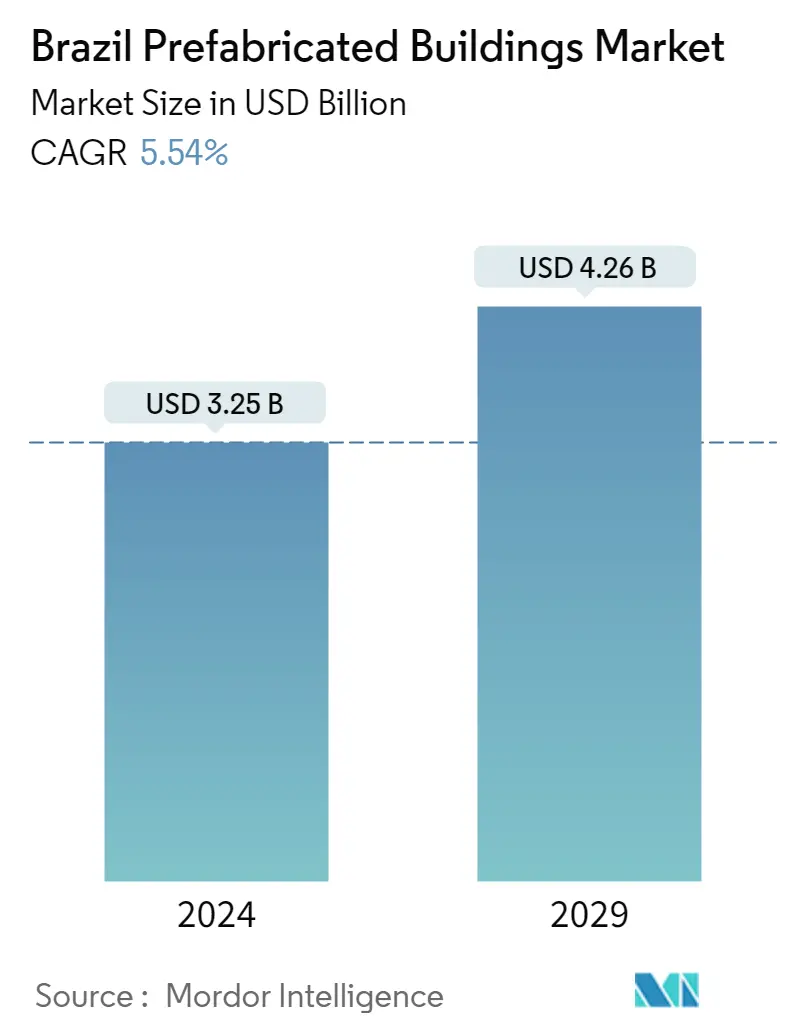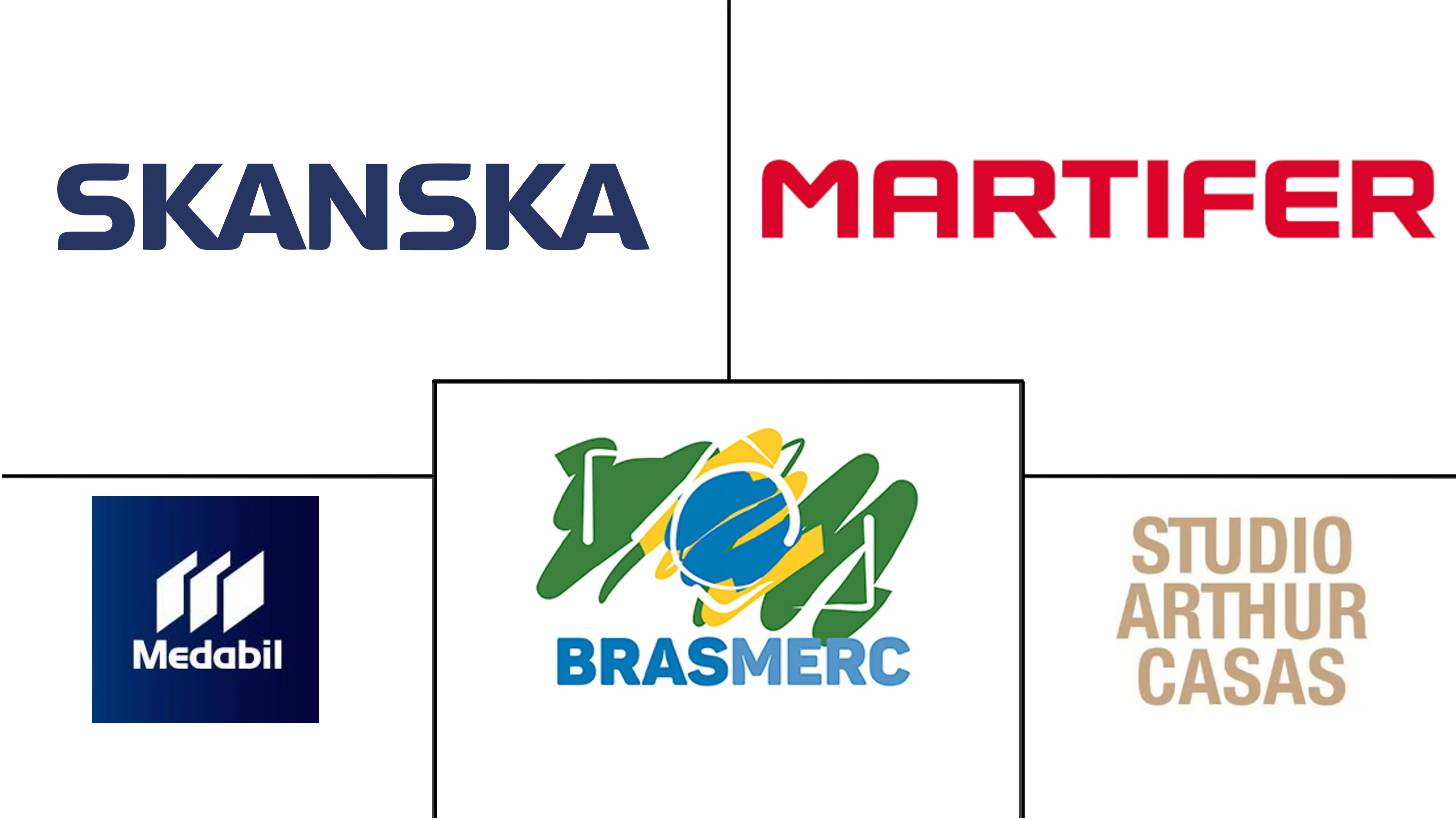Market Size of Brazil Prefabricated Buildings Industry

| Study Period | 2020 - 2029 |
| Base Year For Estimation | 2023 |
| Market Size (2024) | USD 3.25 Billion |
| Market Size (2029) | USD 4.26 Billion |
| CAGR (2024 - 2029) | 5.54 % |
| Market Concentration | Medium |
Major Players
*Disclaimer: Major Players sorted in no particular order |
Brazil Prefabricated Buildings Market Analysis
The Brazil Prefabricated Buildings Market size is estimated at USD 3.25 billion in 2024, and is expected to reach USD 4.26 billion by 2029, growing at a CAGR of 5.54% during the forecast period (2024-2029).
- Modular construction is new in the country, especially for housing. However, as in many other countries, "the pandemic, especially the hospital built in China, brought lots of attention to modular construction. There are very few suppliers of the materials the market needs. So, customers end up adopting a lot of materials from traditional construction. Providing the kind of finish clients expect can be challenging, given the lack of options available. The transport regulations do not allow manufacturers to transport larger units by road, which are not always well-maintained,
- Small projects in Brazil are rising for commercial tourism, taking advantage of cost-effective and fast prefabrication construction techniques. Due to the economy, rationalization, and work speed, the largest of Brazil's school projects are designed from prefabricated concrete elements with rigid modulations and, in rare cases, steel.
- The Brazilian company Urban3D is prefabricating the parts of buildings and then assembling them on-site to combat Brazil's housing crisis. This method requires human workers to assemble the buildings. It also shows how the techniques of 3D printing can be used to quickly and efficiently support the needs of society. Driven by the housing crisis, affordable and smart housing, the prefabricated buildings industry is expected to grow during the forecast period.
Brazil Prefabricated Buildings Industry Segmentation
A prefabricated building, informally a prefab, is a building that is manufactured and constructed using prefabrication. It comprises factory-made components or units transported and assembled on-site to form the complete building.
Brazil's Prefabricated Buildings Industry is segmented by material type (concrete, glass, metal, timber, and other material types) and application (residential, commercial, and other applications (industrial, institutional, and infrastructure)). The report offers market size and forecasts for the Brazil prefabricated buildings industry in value (USD) for all the above segments.
| Material Type | |
| Concrete | |
| Glass | |
| Metal | |
| Timber | |
| Other Material Types |
| Application | |
| Residential | |
| Commercial | |
| Other Applications ( Industrial, Institutional, and Infrastructure) |
Brazil Prefabricated Buildings Market Size Summary
The Brazil Prefabricated Buildings Market is poised for significant growth over the forecast period, driven by the increasing adoption of modular construction techniques. Despite being a relatively new concept in Brazil, modular construction has gained attention, particularly during the pandemic, as it offers cost-effective and rapid solutions for building projects. The market is characterized by a limited number of suppliers, which often leads to the use of traditional construction materials to meet client expectations. The housing crisis in Brazil, coupled with government incentive programs like Casa Verde Amarela and Sistema Brasileiro de Poupança e Empréstimo, has created a substantial demand for affordable housing solutions, further propelling the market's expansion. The use of prefabricated concrete elements in school construction projects highlights the sector's potential to address urban infrastructure needs efficiently.
The market landscape is moderately competitive, with several startups and established companies like Urban3D and SysHaus driving innovation in prefabricated building systems. These companies are leveraging advanced technologies, such as 3D printing, to enhance construction efficiency and sustainability. The demand for precast concrete is expected to rise, supporting cement production and sales, despite a temporary downturn in the construction sector due to economic challenges. The real estate sector, particularly residential projects, is anticipated to recover, bolstering cement consumption. Upcoming major projects and the introduction of smart, sustainable homes are expected to further stimulate market growth. The integration of automation platforms by companies like Construtech Ambar aims to streamline the construction and renovation processes, enhancing the overall efficiency of the Brazilian construction industry.
Brazil Prefabricated Buildings Market Size - Table of Contents
-
1. MARKET INSIGHTS
-
1.1 Current Market Scenario
-
1.2 Technological Trends
-
1.3 Insights on Supply Chain/Value Chain Analysis of the Prefabricated Buildings Industry
-
1.4 Brief on Different Structures Used in the Prefabricated Buildings Industry
-
1.5 Cost Structure Analysis of the Prefabricated Buildings Industry
-
1.6 Impact of COVID 19
-
-
2. MARKET SEGMENTATION
-
2.1 Material Type
-
2.1.1 Concrete
-
2.1.2 Glass
-
2.1.3 Metal
-
2.1.4 Timber
-
2.1.5 Other Material Types
-
-
2.2 Application
-
2.2.1 Residential
-
2.2.2 Commercial
-
2.2.3 Other Applications ( Industrial, Institutional, and Infrastructure)
-
-
Brazil Prefabricated Buildings Market Size FAQs
How big is the Brazil Prefabricated Buildings Market?
The Brazil Prefabricated Buildings Market size is expected to reach USD 3.25 billion in 2024 and grow at a CAGR of 5.54% to reach USD 4.26 billion by 2029.
What is the current Brazil Prefabricated Buildings Market size?
In 2024, the Brazil Prefabricated Buildings Market size is expected to reach USD 3.25 billion.

